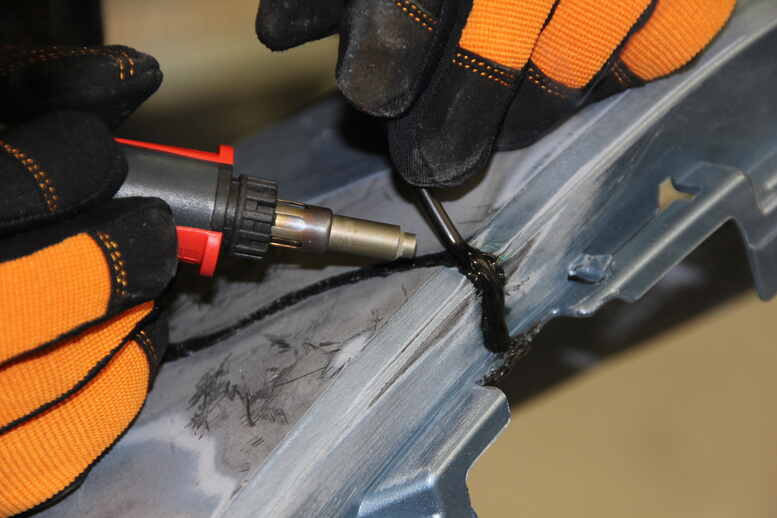Viral
The Different Types of Guns: A Complete Guide

About forty percent of American households own at least one gun. Guns have been part of American culture for as long as the country has been around.
But if you are someone who is just learning about guns, you might not understand just how many different types of guns there are. And how these types differ from one to the other.
There are all types of guns available to consumers today. Guns are usually divided into two categories, long guns and handguns. Long guns include weapons like shotguns and rifles while handguns include pistols and revolvers.
As a general rule, a long gun fires a large-caliber round from a long barrel. These guns are meant to be fired from the shoulder. Handguns are smaller-caliber weapons and are fired with one or both hands.
If you’d like to learn more, then keep on reading and we will take you through the different types of guns that you need to know about!
DIY Guns
You should be aware that most guns nowadays, particularly semi-automatic rifles, can be generalized into two categories: completely finished and 80 lower.
Most guns with a split receiver setting are often composed of two receivers: upper and lower. An 80% lower particularly refers to the lower receiver. The lower receiver is legally important as it often contains the serial number once it’s finished to become a legal firearm. Not to mention that it contains most of the basic parts of the gun: trigger and magazine part groups.
Nowadays, most guns can be bought in parts and disassembled. If a person wants to build, customize, or assemble a gun by themselves, they can separately buy receivers. However, it’s more convenient if they buy an 80% lower receiver as it can let them bypass a few headaches.
Note that a gun with an 80% lower receiver is an ‘incomplete gun’—or a DIY gun as some prefer to call it. They’re incomplete primarily because the finishing required and serial to complete are not present yet.
When a gun has an 80% lower, the Bureau of Alcohol, Tobacco, Firearms, and Explosives (ATF) doesn’t consider it a legal firearm yet. This allows an aspiring gun builder or hobbyist to avoid the need to get licenses, pay fees, and go through tons of paperwork if they want to tinker with guns.
The AR-308, AR-15, and AR-9 are some of the guns often DIY’d with an 80% lower receiver.
Bolt Action Rifles
The bolt action rifle is the simplest form of firearm these days.
It is fired by manually pushing a bolt forward and then pulling a trigger. The bolt is then pulled back and the empty cartridge is discarded.
Because of its manual nature, this is an extremely precise gun but it is also slow to fire. A bolt action rifle will usually hold between five and ten bullets in a detachable or internal magazine.
The Howa 1500 and Remington 700 are two examples of bolt action rifles.
Lever Action Rifles
These rifles have been around for more than 100 years. They are the kinds of rifles that you typically see in cowboy movies.
You pull a lever that’s connected to the gun to load a new bullet. You then pull the trigger and then empty the cartridge and load a new one.
This is a much faster gun thanks to the position of the level.
The Marlin 336 and Winchester 94 are two modern examples of these kinds of rifles.
Semi-Automatic Rifles
When you hear people talking on the news and radio about guns and politics, they are probably going to be talking about semi-automatic rifles. There is a big variety when it comes to these guns.
However, the one common feature is that you release one bullet with one pull of the trigger. A new round is then automatically loaded.
If this kind of gun is referred to as automatic, it is because the round is automatically loaded. An “automatic gun” would also be considered a machine gun.
The process of automatically loading a new round typically involves, recycling some of the weapon’s gunpowder gases and using it to eject the old bullet and load a new one.
A lot of semi-automatic rifles have external magazines that can hold up to thirty rounds. These magazines can be quickly changed to reload the weapon.
Examples of semi-automatic weapons include the Browning BAR rifles and the AR-15.
It’s very important that you maintain your weapons properly. You can visit this website to find the necessary accessories for your guns.
Revolvers
If you’re watching a Western movie and you see a cowboy with a handgun, then he’s definitely got a revolver in his hand. These were the first multi-shot handguns to come around. They can store up to seven rounds in one revolving cylinder.
The cylinder connects to the firing mechanism and the gun barrel. In today’s revolvers, one pull of the trigger advances the cylinder to a new bullet. You pull the hammer back and then release it to strike the primer.
Today’s revolvers are considered to be semi-auto guns. The Ruger GP100 and the Smith & Wesson Model 686 are examples of revolvers available today.
Pistols
A pistol is a handgun that doesn’t use revolving cylinders. While there are some single-shot pistols out there, a lot of the pistols that are available these days are semi-automatic guns. They load cartridges from an attachable magazine that is located on the grip.
As opposed to revolvers, which are usually limited to six or seven bullets, modern pistols today can carry up to seventeen rounds in one magazine.
The Army’s new M17 Modular Handgun System, also known as the Sig P320, as well as the Glock 17 are two examples of modern pistols.
Machine Gun
A machine gun is any gun that shoots automatically more than one shot without being reloaded. Machine guns are rifles that have long, grooved bores.
The bullet goes into the barrel as it’s propelled forward. The grooves spin the bullet so that it fires straight.
When a bullet is fired, it goes one way and the casing goes another way. The energy from this action is used to operate a spring bolt. As the bolt moves backward after the bullet gets fired, it ejects the casing.
As the bolt hits the sping and begins to move forward, it will force another bullet into the barrel of the gun and hit the firing pin.
As long as the trigger is being pulled, the cycle will continue.
The Importance of Knowing About the Different Types of Guns
Hopefully, after reading the above article, you now have a better idea of what the different types of guns out there are. As we can see, there are a lot of options out there when you are looking for the right gun to get.
Make sure to check out the rest of our site for more helpful articles like this one!
Viral
Why You Need A Plastic Welding Kit


Plastic welding kits are a must-have for plastic fabrication, repair, and modification. Whether you work in the plastic industry or you’re a lover of DIY projects, with a plastic welding kit, you can get more done without the need for a professional. So, in essence, you’re saving time, money, and energy! There are many applications, but the question remains: when exactly does it come in handy?
Why Replace It When You Can Repair It?
People quickly throw out broken plastic materials because the thought of repairing them is tiring. But, if you work in the plastic industry or you’re a DIY enthusiast, then you would know that no plastic is beyond repair unless it’s shattered to powder.
Rather than replace your favorite plastic materials, you can grab a kit and fix it. From plastic furniture to automotive parts and garden tools, a plastic repair kit has what it takes to restore your household plastic items.
Long Lasting Repairs
If you want industry-grade repairs without the need for a plastic welder, what you need is a solid plastic kit. There are different types of kits, all curated specifically for different grades of repairs. But for household projects, a basic plastic repair kit will do. A typical plastic welding kit contains welding tips, a welding rod, alloy steel staples, a metal brush, and a hot air gun.
The kits always come with a guide. The level of expertise you have doesn’t really matter; as long as you can handle medium-level tools, you should be able to use one.
The Versatility
We’ve said it before, and we’ll say it again: regardless of your industry, niche, or level of expertise, you’ll find use for a plastic welding kit. It can be used;
- Sealing pipe leaks in the plumbing industry
- Fixing bumper cracks and dents in the automotive industry
- To weld plastic sheets in the construction industry
- To repair household plastic materials and take your DIY project to the next level
When used correctly, a plastic welding kit can transform your projects, reduce work time, guarantee seamless repairs, and extend the lifespan of your plastic materials. If you need to learn about plastic welding, check out the latest news in our blog section and stay updated on the latest in the industry.
Read More: Bryan Chatfield Sanders
Viral
Shuttle Service for Wedding Guests: A Perfect Solution for Group Transportation


Planning a wedding comes with countless details, one of which is managing transportation for guests. Many couples want to make sure their guests feel cared for and have a memorable experience from start to finish. Using a shuttle service for wedding guests can solve numerous logistical challenges while adding a touch of elegance to the day. Here’s why a shuttle service is an ideal choice for transporting wedding guests and how they can enhance the experience.
- Enhanced Guest Convenience
One of the primary reasons couples choose shuttle services for weddings is the convenience it offers guests. Weddings often take place at venues with limited parking or remote locations, which can make transportation challenging. A shuttle service eliminates the need for guests to navigate unfamiliar areas or worry about parking. By providing a reliable shuttle, couples can ensure that all guests arrive safely and on time, without the added stress of finding the venue or dealing with traffic. Plus, shuttles can pick guests up from designated hotels or central meeting points, making it easier for everyone.
- Improved Safety and Enjoyment
A shuttle service enhances safety, especially for weddings where guests may be celebrating with a few drinks. By arranging a shuttle, couples allow guests to enjoy the festivities without the worry of driving back late at night or needing a designated driver. Additionally, shuttles provide a space for guests to relax, socialize, and extend the celebration while traveling to and from the venue. For weddings held in secluded locations, shuttle services can help ensure that guests aren’t stranded or dealing with hazardous late-night driving.
- Efficient Time Management
Shuttles can streamline the schedule and help weddings stay on time. With a designated transportation plan, couples can set clear departure and arrival times to keep the day on track. Shuttle services allow couples to manage the flow of guests, ensuring everyone arrives promptly for the ceremony and that the celebration begins as planned. Shuttle drivers are experienced in working with event timelines, which helps avoid delays and ensures a smooth, enjoyable experience for all.
- Cost-Effective Solution for Group Travel
For couples hosting a larger wedding, providing transportation might seem costly initially, but it can be surprisingly affordable, especially when compared to individual travel arrangements for numerous guests. Shuttle services often offer packages for weddings, and the cost of renting a shuttle is typically lower than arranging multiple taxis or rideshare vehicles. Additionally, guests won’t have to worry about the cost of parking or arranging separate transport options, which can be particularly valuable for out-of-town attendees.
- A Cohesive Experience and Added Luxury
Shuttle services can add an element of luxury and thoughtfulness that many guests appreciate. Offering a shuttle creates a seamless, coordinated experience that reflects the couple’s attention to detail and care for their guests’ well-being. Some couples even decorate the shuttles to match their wedding theme or provide music and refreshments, turning the shuttle ride into an extension of the celebration. These personal touches can make the experience more memorable and enjoyable.
- An Eco-Friendly Transportation Choice
For environmentally conscious couples, shuttle services offer a more eco-friendly transportation option. By consolidating transportation into one or a few vehicles rather than multiple individual cars, shuttle services help reduce the wedding’s overall carbon footprint. This is especially beneficial if the venue is in a remote location, as it minimizes emissions from guest vehicles. Some shuttle companies even offer eco-friendly fleet options, making it a sustainable choice for group travel.
- Accommodates Guests with Special Needs
Shuttle services can be especially helpful for guests who may need extra assistance, such as elderly relatives or those with mobility issues. Many shuttle companies offer ADA-compliant vehicles equipped with wheelchair ramps or other features to ensure comfort for all guests. This added convenience can be invaluable for guests who might otherwise have difficulty with standard transportation options.
- Planning Tips for a Smooth Shuttle Experience
To ensure a seamless shuttle service experience, there are a few planning tips couples should keep in mind:
- Book Early:Shuttle services are popular for weddings, especially during peak wedding season. Booking early ensures availability and allows time to coordinate pickup and drop-off points.
- Communicate with Guests:Let guests know about the shuttle schedule and pickup locations in advance, either in the invitation or through a wedding website. Providing this information helps everyone plan accordingly and reduces last-minute confusion.
- Consider Multiple Trips:If your guest list is large, consider arranging for multiple trips to accommodate everyone. This way, guests can choose from different pickup times that work best for them.
- Coordinate with the Venue:Work with your venue to establish clear pickup and drop-off areas. Some venues have specific spots for shuttles, and this helps make the process more organized.
Conclusion
Offering a shuttle service for wedding guests is a thoughtful gesture that provides convenience, safety, and an added touch of luxury to your special day. From cost savings to an improved guest experience, a shuttle helps ensure that everyone arrives at the wedding relaxed, on time, and ready to celebrate. For couples looking to simplify logistics and create a memorable day for their loved ones, shuttle services are a practical, elegant solution that truly enhances the wedding experience.
Viral
Should You Choose Open or Closed Cell Spray Foam?


Having your building properly insulated is of utmost importance in this day and age of rising energy costs and increasing environmental concerns. Among the many insulation options available, spray foam stands out, known for its remarkable efficiency and unique properties.
But when diving into the world of polyurethane foam, you are immediately met with a choice: open cell or closed cell? Each comes with its own set of benefits and considerations. Let’s take a closer look.
Spray Foam Insulation: The Basics
Derived from a synthetic polymer blend, spray foam insulation plays a pivotal role in enhancing energy efficiency. It’s widely used to insulate walls, roofs, and other sections of buildings, cutting down those hefty heating and cooling bills. Beyond residential structures, you’ll find it guarding pipes, tanks, and machinery in industrial settings.
So, what makes it so versatile? The answer lies in its creation. By mixing multiple liquid components, including those with heat-insulating agents, this foam offers unparalleled insulation advantages. But not all foams are created equal.
Open Cell Insulation
1. What’s it like?
Open cell foam is softer and more flexible, expanding significantly upon application – up to a whopping 100 times its initial size!
2. Air’s Arch-nemesis:
Boasting a density of 0.4 – 0.6 lbs/cubic foot, it’s a champion in reducing air leaks, which can have a direct impact on indoor air quality.
3. Silence, Please:
If you’re looking to mute those external noises, open cell is your ally. It’s exceptional at dampening sounds and vibrations.
4. Adaptable and Tenacious:
As buildings shift over time, open cell foam remains resilient, enduring seasonal changes without cracking.
5. Easy on the Wallet:
Budget-conscious homeowners rejoice! Open cell insulation is generally more affordable due to its lower installation resource needs.
6. A Few Shortcomings:
It does have a lower R-value (3.5 – 3.9 per inch), so its thermal resistance isn’t as high. Additionally, it doesn’t act as a moisture barrier, which could invite mold or structural damage. And, to safeguard against fire, UV rays, or pests, you’ll need to add extra protective layers.
Closed Cell Insulation
1. What’s it like?
Unlike its open-cell counterpart, closed cell foam is dense and rigid, expanding to depths of about 30-50mm.
2. The Impenetrable Fortress:
With a density of 1.5 – 2 lbs/cubic foot, closed cell acts as both an air and moisture barrier, championing superior thermal resistance.
3. Sturdy and Strong:
One of its crowning glories is the ability to enhance a building’s strength, adhering firmly to the structure.
4. The Price Tag:
Its benefits come at a cost – literally. Closed cell insulation tends to be pricier due to the increased material and labor needs.
5. Impressive Thermal Capacity:
If retaining heat is your primary concern, this foam, with its R-value of 6 – 7 per inch, has got you covered.
6. Barrier Benefits:
Not only does it keep the cold air out, but it’s also a barrier against water, minimizing condensation issues.
7. Built to Last:
Come rain or shine, or the threat of pests, closed cell foam stands firm. However, its rigidity can be both a blessing and a curse. Over time, temperature changes might cause it to shrink and crack.
Final Thoughts
Insulation using polyurethane foam has undeniably revolutionized the world of building insulation. Companies like Isothane are at the forefront, ensuring the quality and efficiency of this material.
When deciding between open and closed cell, consider the specific needs of your project, budget, and long-term goals. Both have their merits, and understanding them can help you make an informed decision, ensuring that your space is comfortable, efficient, and protected for years to come.
For mor information visit https://isothane.com/spray-foam-insulation/
-



 Biography7 years ago
Biography7 years agoJacqulyn Elizabeth Hanley is the Mother of Liza Soberano?
-



 Biography7 years ago
Biography7 years agoAmanda Levy Mckeehan Biography, Family, Net Worth, Age, Affairs, Facts
-



 Home6 years ago
Home6 years agoEpson L3110 Driver Free Download Latest Updated Version
-



 Games4 years ago
Games4 years agoBest Free To Play MMORPG To Try This 2021
-



 Biography7 years ago
Biography7 years agoWho is Rose Dorothy Dauriac? Scarlett Johansson Daughter?
-



 Home7 years ago
Home7 years agoLiza Soberano Biography, Age, Family and Boyfriends
-



 Biography7 years ago
Biography7 years agoJessica Ditzel Secret Information that Nobody Knows | Joe Rogan’s Wife
-



 Biography7 years ago
Biography7 years agoWhat is the relation of Nathaniel Larry Osorno with Liza Soberano?































